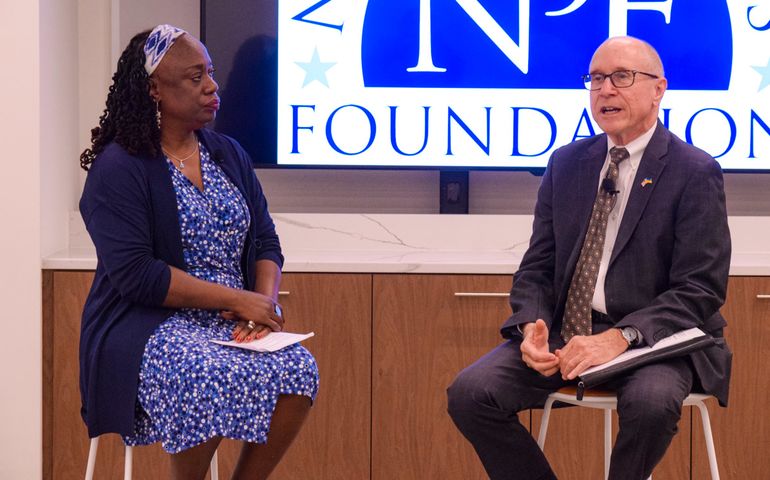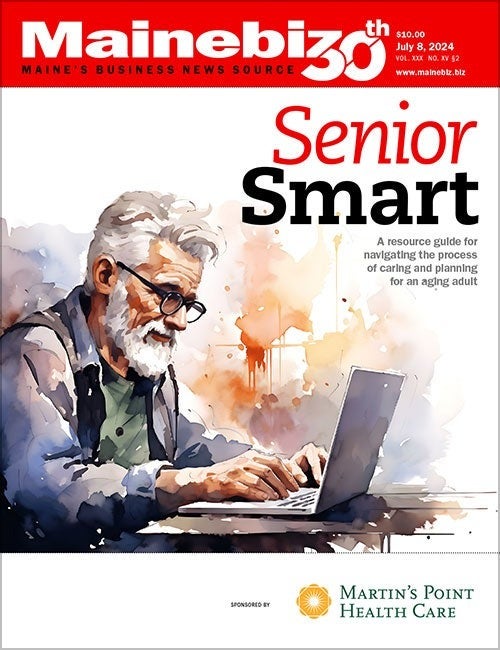
Insights into America’s aging population and retirement
 Photo / Sydney Clark, National Press Foundation
Rachel Jones, left, director of journalism initiatives for the National Press Foundation, interviewing William Beach, Commissioner of the U.S. Bureau of Labor Statistics.
Photo / Sydney Clark, National Press Foundation
Rachel Jones, left, director of journalism initiatives for the National Press Foundation, interviewing William Beach, Commissioner of the U.S. Bureau of Labor Statistics.
Beyoncé belted out “You won’t break my soul,” in a recording played by Jean Accius, calling the song a new rallying cry after COVID forever changed the workforce and workplace. The song serves as inspiration for Accius in his work as a policy expert at AARP, which has 38 million members and advocates on behalf of Americans age 50 and older.

“Ageism is real” and “age discrimination stifles growth,” he told journalists at a three-day fellowship program in Washington, D.C., last month. His suggestion: “We have to connect the workforce with the marketplace.”
The National Press Foundation’s “Living Longer: A New Age for Aging” conference tackled a range of topics from today’s five-generation workforce to the use (and misuse) of Artificial Intelligence in screening job applicants, and retirement and Social Security financing. Here are some takeaways I aim to incorporate into my reporting for Mainebiz.
Wealth distribution ‘extraordinary unequal’
Describing retirement for the average American as a “very modern,” post-World War II phenomenon, Commissioner William Beach of the U.S. Bureau of Labor Statistics noted that Ida May Fuller was the first person to receive a Social Security check, in 1940. That gave the former Vermont school teacher and legal secretary a retirement income until she died at age 100 in 1975.
Fast forward to today’s Baby Boomers, whom Beach calls the healthiest and wealthiest generation ever, with almost $25 trillion in assets transferred from their parents and set to transfer close to $60 trillion to the next generation.
“We have more wealth, we have more income, we are healthier, we are more educated than any generation ever to achieve the median age of 70,” he said. Unfortunately, the assets are “extraordinary unequal,” Beach said.
“Now we have so many more people who are wealthy, but the distribution is enormous,” he added. “This doesn’t necessarily mean that the bottom 10% is poor. It’s just that they are way distant from the top 10%.”
He also said that today’s median retirement savings is $30,000, “which is not enough.”
Fine-tuning retirement policies
America’s aging population profoundly affects the future of work and retirement, according to sociologist Beth Truesdale, co-editor of a newly published book, “Overtime: America’s Aging Workforce and the Future of Working Longer.”
“Americans are living longer on average than they were 50 years ago, and people who are living longer are going to need income for more years of their life,” Truesdale said. “The question is, where is that money going to come from?”
While raising the retirement age is a standard policy response, she said that’s often based on the assumption that the timing of retirement is a choice. In reality, delayed retirement is not feasible for everyone, and promoting longer working “leaves behind those who struggle to maintain employment into their mid-60s and beyond.”
Some of the reasons people leave the workforce early cited in the book: Poor health, caregiving responsibilities, unstable employment, age discrimination and local labor market challenges. Taking this into account, and the rapid drop-off in employment rates between ages 50 and 60 for all education levels, Truesdale suggests a more proactive policy approach.
“When thinking about delayed retirement,” she said, “we need to be looking at policies that are addressing workers a decade or more before traditional retirement ages — in their 40s and 50s — so they’re in a better position to work longer when they get into their 50s and 60s.”
Social Security’s funding shortfall
Contrary to what is often reported, the U.S. Social Security system is not at all bankrupt though it has a funding problem, said Debra Whitman, the AARP’s executive vice president and chief public policy officer.
She said that “shortfall” is a more accurate description, since money is still flowing into the system. However, the current projection is that the revenue coming in will only be able to cover 76% of all benefits by 2035 — meaning a 24% cut in benefits for retirees.
“Most people can’t afford a 24% cut in their Social Security check,” Whitman said. “There would be riots in the street. I do not think it’ll get to that, but every time somebody writes that Social Security will be bankrupt, people don’t believe in the system and that it won’t be there at all for them. And it undermines solutions that could make the program better.”
Age discrimination illegal but hard to prove
Several speakers touched on age discrimination, which has been illegal in the United States since 1967 but difficult to prove, and increasingly so amid the use of Artificial Intelligence-enabled algorithms for recruiting and interviewing job candidates.
While employers are currently allowed to ask job candidates for their age on an application, a bill pending in Congress would make that practice illegal, noted Cristina Martin Firvida, vice president of government affairs at the AARP. More subtle forms of discrimination are job advertisements encouraging “college grads” to apply, she said.
Ageism in popular culture, even in our language and greeting cards, also came up in a talk by Martha Boudreau, executive vice president and chief communications officer at the AARP. She told us that gray hair is very much in fashion — despite the recent firing of Canadian television news anchor Lisa LaFlamme, who says she was let go because she stopped dyeing her hair, at age 58. Boudreau also shared images from the AARP’s “Disrupting Aging” photo database with Getty Images showing older adults leading active, fulfilling lives.
Along a similar note, Ruth Finkelstein, executive director of the Brookdale Center for Healthy Aging at City University of New York’s Hunter College, lamented the fact that prejudice against older individuals remains ‘widely socially acceptable,” yet fewer than 10% of age discrimination claims are settled in the claimant’s favor. She also cited research showing that more than half of workers over 50 are at some point “involuntarily retired,” whether due to a layoff or other reasons, and that those who lose jobs at 50-plus who re-enter the workforce tend to get hired at a lower pay rate.









0 Comments